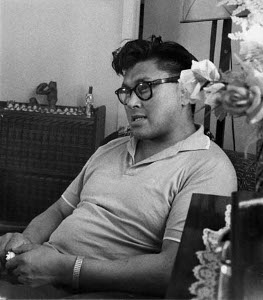Abe Okpik facts for kids
Quick facts for kids
Abe Okpik
|
|
|---|---|
| Auktalik | |

Okpik in April 1964
|
|
| Born | 12 January 1928 |
| Died | 10 July 1997 (aged 69) |
| Occupation | Inuit community leader |
Abraham "Abe" Okpik (born January 12, 1928 – died July 10, 1997) was an important Inuit leader in Canada. He helped Inuit people get proper surnames instead of government identification numbers. He was also the first Inuk person to be part of the Legislative Assembly of the Northwest Territories. This is like a local parliament for the region. Abe Okpik also worked closely with a well-known judge, Thomas Berger.
Contents
Abe Okpik's Early Life
Growing Up in the North
Abe Okpik was born on January 12, 1928. His birthplace was near Aklavik in the Mackenzie Delta area. This is in the Northwest Territories. He was part of the Inuvialuit people.
Before he chose the name Abraham Okpik, he was known as Auktalik. This name means "man with a mole." He chose Abraham as his first name because it's a name from the Bible. Okpik was a family name meaning "willow."
Learning and Healing
Okpik learned English at the All Saints Indian Residential School in Aklavik. When he was 16, he got sick with tuberculosis. He had to go to the Charles Camsell Hospital in Edmonton.
He stayed in the hospital for three years. During this time, he got much better at English. This skill later helped him get a job as a translator. He worked for the Distant Early Warning Line, which was a line of radar stations. Even though he was hurt in a dog sled accident, he could still hunt and trap.
Life in the 1960s
Working in Iqaluit
By the 1960s, Abe Okpik lived in a place called Frobisher Bay. Today, this town is known as Iqaluit. He worked at a rehabilitation center in Apex. Apex was the part of town where most Inuit lived back then.
Later, he worked for the Department of Indian Affairs and Northern Development (DIAND). He was an administrator, helping to manage things for the government.
Joining the Northwest Territories Council
In 1965, Okpik was chosen to join the Northwest Territories Council. This council was like a government body for the region. At that time, most council members were from Ottawa.
Okpik's job was to speak for the Inuit people. He represented those living in the eastern Arctic. His first meeting was on February 4, 1966. He started speaking in his own language. Then he switched to English. He argued for a better life for people in the North. He believed Inuit "must have a voice in development." He was not re-appointed to the council after Simonie Michael was elected in 1966.
Project Surname: Giving Names to People
Why Surnames Were Needed
From the 1940s, the Government of Canada used disc numbers to identify Inuit people. These were like dog tags. They were used because Inuit communities often didn't use last names. Also, people's names could change often. The numbers helped the government give out family allowances.
In the mid-1960s, the Northwest Territories Council decided to change this. They wanted to give Inuit people last names instead of numbers. This plan was called Project Surname. Abe Okpik, whose own disc number was "W3-554," was chosen to lead this important project.
Okpik's Journey for Names
From 1968 to 1971, Okpik traveled all over the North. He visited every community and many traditional camps. These places were in the Northwest Territories, what is now Nunavut, and Nunavik in northern Quebec.
He visited 55 settlements in total. He traveled by plane, snowmobile, boat, and even snowshoe! At each place, Okpik would write down people's names. He explained why having a first and last name was important. He used a naming style common in Europe and Canada. This meant that usually, the father chose a surname. That name then became the family's last name.
After the project, Okpik went back home. He lived in Frobisher Bay with his wife and three children. He also worked as a teacher at Frobisher Bay School.
The Berger Commission
In 1974, the Canadian government asked Thomas Berger to lead an inquiry. This was called the Mackenzie Valley Pipeline Inquiry. It was about a proposed pipeline project.
The inquiry lasted longer than expected. It traveled through 35 northern communities. Abe Okpik went with Berger on this journey. He worked as both an interpreter and a broadcaster. He helped make sure everyone understood each other.
Order of Canada
Abe Okpik was recognized for his amazing work. This included his efforts with the "Berger Commission," on the NWT Council, and for "Project Surname." He was made a "Member of the Order of Canada." This is a very high honor in Canada. He received this award on December 15, 1976. The official ceremony was on April 20, 1977.
Later Life and Legacy
Returning to Iqaluit
In 1979, Abe Okpik returned to Iqaluit. He had also spent time on Banks Island and in Spence Bay, which is now called Taloyoak.
He spent the rest of his life in Iqaluit. He was elected to the town council many times. He also volunteered for many groups and committees.
Death and Memorials
Abe Okpik passed away in Iqaluit on July 10, 1997, after an illness. His funeral was held at St. Jude's Cathedral on July 15.
A building in Apex, Iqaluit, is named after him. It's called the "Abe Okpik Hall." In 1998, the former mayor of Iqaluit, Jimmy Kilabuk, had a mural painted on his home. This mural included a picture of Abe Okpik, honoring his memory.

